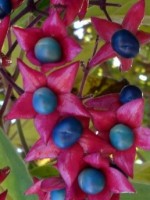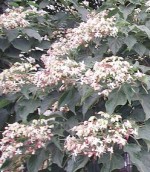 This large coarse shrub, native to China and Japan, is deciduous or semi-evergreen, and is cultivated for its scented flowers and unusual berries. It is a member of the deadnettle family, Lamiaceae, that also includes ajuga, beebalm, and mint. Growing to fifteen feet tall and wide, it can be trained as a small tree but is more often seen as a suckering shrub. In mid- to late-summer, the plant produces clusters of very fragrant white flowers that are followed by brilliant blue berries surrounded by a fleshy red calyx. The dark green leaves are downy and produce an odor resembling peanut butter or green peas when crushed. Use in shrub border. Plants grown in the northern range of their zone may die back in winter but will return in spring. The genus name, Clerodendrum, comes from the Greek words kleros meaning chance and dendron meaning tree and may refer to the variable medicinal qualities of the plants. The specific epithet, trichotomum, may be derived from Greek, and mean three-forked or triple-branched.
This large coarse shrub, native to China and Japan, is deciduous or semi-evergreen, and is cultivated for its scented flowers and unusual berries. It is a member of the deadnettle family, Lamiaceae, that also includes ajuga, beebalm, and mint. Growing to fifteen feet tall and wide, it can be trained as a small tree but is more often seen as a suckering shrub. In mid- to late-summer, the plant produces clusters of very fragrant white flowers that are followed by brilliant blue berries surrounded by a fleshy red calyx. The dark green leaves are downy and produce an odor resembling peanut butter or green peas when crushed. Use in shrub border. Plants grown in the northern range of their zone may die back in winter but will return in spring. The genus name, Clerodendrum, comes from the Greek words kleros meaning chance and dendron meaning tree and may refer to the variable medicinal qualities of the plants. The specific epithet, trichotomum, may be derived from Greek, and mean three-forked or triple-branched.
 Type: Deciduous or semi-evergreen shrub or small tree
Type: Deciduous or semi-evergreen shrub or small tree
Outstanding Feature: Fragrant flowers; bright colored berries
Form: Rounded
Growth Rate: Fast
Bloom: Clusters of small fragrant white flowers are produced in mid-to late-summer followed by bright blue berries surrounded by red fleshy calyx
Size: 10-20’ H x 10-20’ W
Light: Full sun preferred but some shade tolerated at the expense of flowers and berries.
Soil: Organically rich, moist, well-drained
Hardiness: Zones 7-9 (6 if grown in protected site with mulch and treated as perennial, i.e. cut back in early spring before new growth begins.)
Care: Remove suckers to prevent plant from becoming invasive
Pests and Diseases: None of significance but susceptible to whiteflies, mealybugs, aphids, cankers, galls, and leaf spot.
Propagation: Semi ripe cuttings in summer; root cuttings in winter.
Photo Credit: Wikipedia
